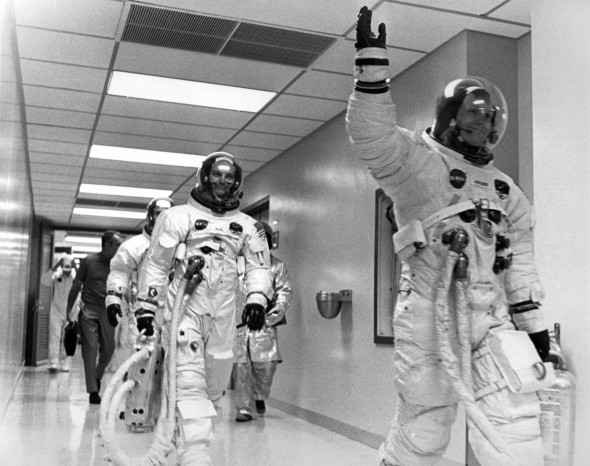President Obama likely agrees about robots, since he canceled the manned successor to the space shuttle, the Constellation project and there is no valid replacement in sight.
With the space shuttle over, people have given it a lot more honest reassessment that they did in the past - before a week ago, virtually no one in science media would do anything except be a cheerleader for the thing. But the space shuttle also did something positive - it showed us newer is not always better. Some old NASA stuff is still pretty cool.
When talking about the Mercury program, for example, and comparing the NASA of that time to that of today, I noted that we can still fire up an Apollo RS-18 engine from 39 years ago and it works just fine, so it shouldn't take 16 years to go back to the Moon when it only took 9 years the first time. We've lost our way because space started being about science and not about boldly going where no man has gone before.
Space travel is still cool and people will embrace it, but it has to be about people and not experiments. Most people love to think about astronauts when they think of space and I love to think about the computers and ground systems and predictive analysis that got astronauts into space(1) but few people think girdles when they think about the space program. And people made those girdles, and that makes it cool.
Yes, girdles. The spacesuits were made by Playtex, which is in lots of different businesses, but was notable then for making girdles. See what I mean:
No mention of NASA in that commercial, right? Well, contractors were not allowed to brand anything and, in the spirit of being mission-oriented, NASA did not highlight individual contractors so IBM's ground systems work gets scant mention in the otherwise comprehensive This New Ocean history they created and I can't find Playtex mentioned anywhere at all(2) - except by the always-interesting Txchnologist, published by GE (why does GE publish anything? No reason I can figure, except they have a century plus of cool science and technology history and dig science outreach, I guess) and architecture professor Nicholas de Monchaux, who has written a whole book on the space suit, called Spacesuit: Fashioning Apollo.
The 21-layer A7L suit was created by the International Latex Corporation but that company was better known by its consumer brand, Playtex, then - the brand is part of separate companies now.
And those spacesuits were made by hand. By seamstresses. Like I said earlier, newer is not always better and no machine was going to beat a human in this instance. "They had to sew to a 1/64th of an inch tolerance without using any pins. So there was no question that it was kind of a couture handicraft object versus something made according to more conventional military industrial principles," said de Monchaux.

Hazel Fellows assembles the shell, liner and insulation cover of a suit at ILC. Courtesy MIT Press.
NASA then was primarily interested in performance - not quotas or social justice or being a job works program - but building a rocket or a spacesuit is actually much simpler than the job NASA has today, because you have manageable variables, rather than making every special interest in culture and the government happy.
So NASA's criteria for picking a contractor was basically to throw a performance spec into a pit and let a bunch of wild dogs go after it. Whichever one did the best job won. How refreshing! Excellence before fairness.

The AirResearch AES suit did not win. Courtesy MIT Press
There was a philosophical aspect to it, he notes. The communist Soviets simply stuck their guy in a glorified womb with an umbilical cord attached, there was no real suit design. They didn't care about the human experience.

And the winner, thanks to a girdle company. Buzz Aldrin, Michael Collins and Neil Armstrong on their way to the SaturnV/Apollo 11 vehicle. Courtesy MIT Press
de Monchaux echoes what I believe about the human endeavor also; "One thing that people often misunderstand about the Apollo program was that it was not a scientific or technical enterprise at all. It was really an enterprise in image creation. The imagery of spaceflight was a powerful and tangible weapon in the Cold War. Once that image of an American on the moon had been produced, people were less enthralled. With researching this book, I came to see the space race as something that extended further back into our history. In the 18th Century you had a kind of space race between the French and the English about whose balloons were going higher."
It's no different today. People want to go higher. NASA may not be nimble enough to do it today but the private sector might still take us to Mars.
NOTES:
(1) And if you don't like to think about astronauts or the computing system that got them there, you at least probably like to think about the prospect of meeting alien babes.

Claudia Black, your favorite Peacekeeper, is only a wormhole away.
(2) Most people have also never heard of the Woman in Space Program and the Mercury 13 women. But if you read that link, you will know all.



Comments